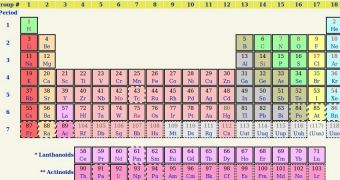The International Union of Pure and Applied Chemistry (IUPAC) has officially recognized the name of the heaviest chemical in the world, until now named Element 112. The substance was called thus because it features 112 protons in its nucleus. This makes it about 277 times heavier than hydrogen, and the heaviest atom ever created. Periodic tables around the world would now have to be rewritten, as the element has finally received its final name. Inspired by the astronomer Nicolaus Copernicus, whose contribution to developing the heliocentric cosmology model still in use today was outstanding, experts decided to rename Element 112 as Copernicium, and to abbreviate it as “Cn”, LiveScience reports.
This name was proposed by a team of researchers based at the GSI Helmholtzzentrum fur Schwerionenforschung, in Germany, who initially discovered this element. The research group was led by expert Sigurd Hofmann, and scientists there say that they wanted to stick to the traditional trend in naming new chemical elements after respected and influential researchers. Copernicus lived between 1473 and 1543, and is credited as being the first to formulate the principle that the Earth revolves around the Sun, and not the other way around. All aspects of modern astronomy are believed to be founded on a single book, called De revolutionibus orbium coelestium "On the Revolutions of the Celestial Spheres," that Copernicus published immediately before his death.
The IUPAC announced on February 19 that it officially endorses the German proposal for renaming Element 112. The data on which the announcement was made was a symbolic one, as February 19 marks the famed astronomer's birthday. What scientists couldn't agree on at first was the element's abbreviation. The Germans had proposed “Cp,” but this is already used in other areas of science already, as for example to illustrate a certain material's specific heat. So the scientists eventually agreed to use “Cn” instead, though this isn't the most intuitive abbreviation for Copernicium. The new name is added to other famous ones on the Periodic Table, including Albert Einstein (Einsteinium), Enrico Fermi (Fermium), and Pierre and Marie Curie (Curium).
The GSI team first produced Element 112 in their lab's 100-meter-long particle smasher, as far back as February 9, 1996. The atoms that were first discovered only remained stable for a small fraction of a second, given the fact that they have such a large mass. They were produced by firing zinc ions into lead targets, causing nuclei of atoms in the two chemicals to fuse together and form Copernicium. Over the past 14 years, teams around the world have replicated these results, and so in 2009 the IUPAC officially recognized the existence of the element, and told the German team to pick a name for it.

 14 DAY TRIAL //
14 DAY TRIAL //